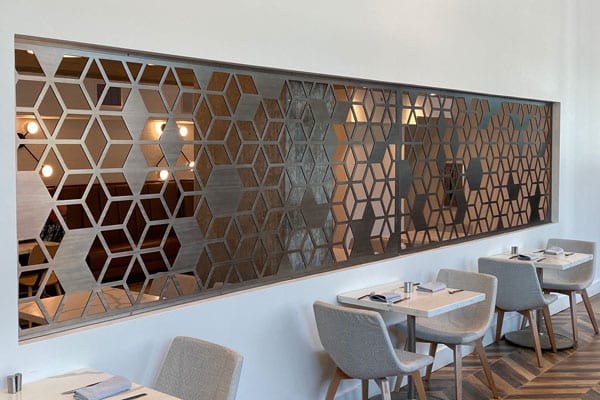Architectural sheet metal facades offer a versatile and durable option for modern building exteriors. You benefit from materials that protect structures while allowing for creative designs and customization. Sheet metal is valued for its resistance to weather, ease of installation, and ability to create sleek, contemporary looks.
When you choose sheet metal for your facade, you gain access to a range of finishes and textures that can enhance aesthetic appeal and improve building performance. These facades require minimal maintenance, making them practical for long-term use. Understanding how sheet metal works in architecture helps you make informed decisions for both commercial and residential projects.
Your building’s exterior can strike a balance between function and form with sheet metal facades. By selecting appropriate metal types, such as aluminum or steel, you control factors like durability, weight, and cost. This flexibility makes sheet metal a popular choice in architectural design.
Key Aspects of Architectural Sheet Metal Facades
You will find that architectural sheet metal facades involve a combination of design flexibility, exact fabrication processes, and tailored cladding solutions. These elements work together to deliver sophisticated facades, including curved and parametric panel systems that meet the demands of modern architecture.
Modern Designs and Aesthetic Trends
Modern metal façade design emphasizes clean lines, varied textures, and subtle color treatments that enhance the building’s aesthetics. You can use sheet metal in different finishes—matte, glossy, perforated, or embossed—to achieve distinctive visual effects and respond to urban contexts.
Metal facades often incorporate patterns or three-dimensional profiles to create depth and visual interest. These trends also prioritize sustainability, with materials selected for their durability and recyclability. Your design can strike a balance between aesthetics and energy efficiency by choosing the appropriate metal types and coatings.
Precision Fabrication Techniques
Using precision sheet metal for architecture ensures tight tolerances and consistent quality. Advanced CNC cutting, laser profiling, and automated bending enable the production of complex shapes with precise dimensions.
These fabrication methods reduce errors and speed up installation. Your project benefits from reliable, repeatable components, whether in the form of straight panels or intricate connections. Precision fabrication also supports lightweight construction, improving facade performance without sacrificing strength.
Custom Cladding Solutions
Custom metal cladding fabrication enables you to tailor facades to the unique shapes and functional requirements of your building. You can specify thickness, coatings, and material types to address climate conditions and architectural styles.
Customization includes integrating insulation, ventilation, or lighting systems within the cladding. This flexibility gives you control over both appearance and performance. Using sheet metal in this way allows for efficient, long-lasting facades that are engineered to meet your project’s exact needs.
Parametric and Curved Panel Systems
Parametric metal facade systems enable you to explore complex geometries through algorithm-driven design, which can be translated into precise fabrication instructions. This approach enables the creation of dynamic surfaces that adapt to changes in light and angle.
Curved metal panel fabrication uses advanced forming techniques to produce smooth, flowing shapes. You gain aesthetic versatility while maintaining the structural integrity of sheet metal. Parametric and curved systems are ideal if your design calls for unique, non-linear facades that stand out with technical rigor.
Performance, Sustainability, and Applications
You will find that architectural sheet metal facades combine durability with sustainable features and versatile uses. Their performance in harsh environments, energy efficiency, and wide-ranging applications makes them highly valuable for modern construction.
Sustainable Building Envelopes
Sheet metal plays a key role in creating sustainable metal building envelopes that protect structures while minimizing environmental impact. It is highly recyclable, often containing a significant percentage of recycled materials, which reduces demand for raw materials.
These facades contribute to durability through resistance to corrosion and weathering, thereby extending the building’s life. Additionally, sheet metal allows for designs that facilitate natural ventilation or incorporate rainwater harvesting, further supporting sustainability goals.
Using sheet metal can also reduce construction waste because it can be precisely fabricated off-site, minimizing on-site cuttings and leftover materials. This efficiency in both material use and fabrication effectively supports sustainable building practices.
Energy Efficiency and Environmental Benefits
Architectural sheet metal facades enhance energy efficiency by providing thermal insulation and reflective surfaces, thereby reducing energy consumption. Metals like aluminum and zinc reflect solar radiation, helping to maintain stable indoor temperatures.
The use of ventilated metal facades improves airflow between the metal skin and the building wall, reducing heat buildup and lowering cooling costs. Additionally, sheet metal facades support the installation of insulation layers without increasing structural weight.
Environmentally, sheet metal facades contribute to reduced carbon footprints through recyclability and long service life. They also require less frequent maintenance and replacement compared to some other facade materials, leading to lower environmental strain over time.
Notable Architectural Applications
You will see architectural sheet metal facades in a wide range of buildings, from commercial towers to cultural institutions. Their adaptability makes them suitable for both contemporary and historic renovations.
Examples include the use of perforated sheet metal on museums to create dynamic light patterns or folded metal panels on office buildings for a sleek, modern aesthetic. The material’s lightweight properties enable the creation of creative shapes and complex geometries that would be difficult with heavier materials.
In urban environments, these facades often serve dual purposes, combining aesthetics with functionality such as sun shading or noise reduction. Their widespread application confirms their importance in modern metal facade design.
Reference
*Image from https://mozdesigns.com/

